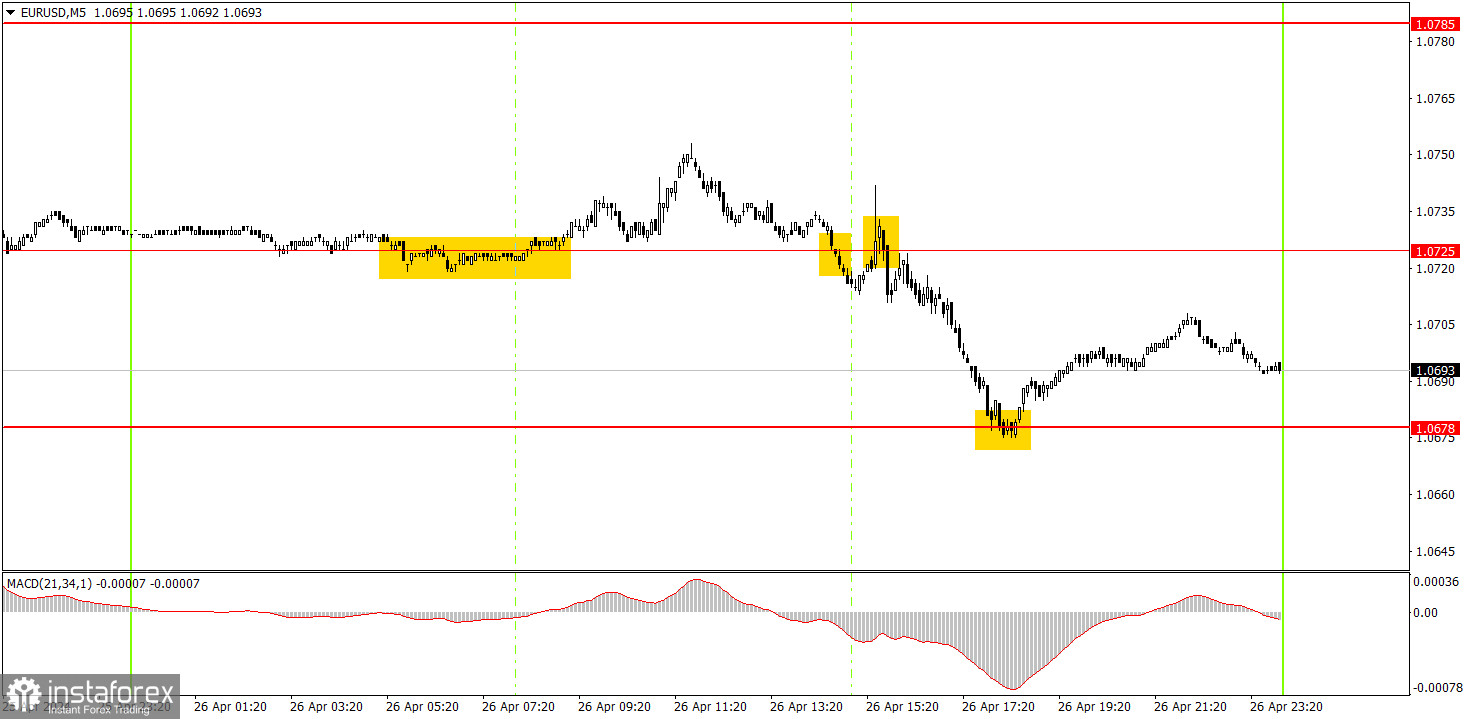Analyzing Friday's trades:
EUR/USD on 1H chart

EUR/USD started falling on Friday, which was justified by technical reasons. Over the past few days, the price has been hovering near the upper boundary of the ascending channel, so a bounce from it and a shift towards a downward movement seemed likely. This didn't even require a corresponding macroeconomic backdrop. The US reports that were released on Friday did not support the greenback. To be more precise, there were four US reports, three of which weren't enough for the greenback. Overall, the recent US reports left much to be desired. The GDP report for the first quarter was extremely disappointing, which unexpectedly slowed down to 1.6%. Actually, the slowdown in the US economy cannot be considered something extraordinary, given that the Federal Reserve's policy has been quite hawkish for quite some time. However, we still expected a higher value. And we were not alone in this.
EUR/USD on 5M chart
Several trading signals were generated on the 5-minute timeframe. At the beginning of the European trading session, the pair bounced off the level of 1.0725 but only managed to rise by 15 pips, which was enough to set the stop loss to breakeven. Then, two sell signals were formed near the same level of 1.0725, after which the price reached the nearest target level of 1.0678. The profit from the short position was about 25 pips. The bounce from the level of 1.0678 could have been executed, but this signal formed quite late, so it was better not to enter the market before it was closed.
Trading tips on Monday:
On the hourly chart, the downtrend persists, but the EUR/USD pair is currently correcting higher. We believe that the euro should continue to fall in the medium term, as it is still too high, and in general, the trend is headed downwards. However, at the moment, the market is likely taking a break before it starts a new downward movement.
On Monday, the pair may resume its downward movement as it bounced off the upper boundary of the channel. If the price consolidates below the ascending channel, it would signal the start of a new leg in the downward trend.
The key levels on the 5M chart are 1.0483, 1.0526, 1.0568, 1.0611, 1.0678, 1.0725, 1.0785-1.0797, 1.0838-1.0856, 1.0888-1.0896, 1.0940, 1.0971-1.0981. The eurozone will publish an important inflation report for Germany. Inflation is expected to accelerate to 2.3%, which is not critical for either the European Central Bank or the euro. It may only provoke a market reaction in the case of a significant deviation of the actual value from the forecast. The market may buy the euro if inflation accelerates.
Basic trading rules:
1) Signal strength is determined by the time taken for its formation (either a bounce or level breach). A shorter formation time indicates a stronger signal.
2) If two or more trades around a certain level are initiated based on false signals, subsequent signals from that level should be disregarded.
3) In a flat market, any currency pair can produce multiple false signals or none at all. In any case, the flat trend is not the best condition for trading.
4) Trading activities are confined between the onset of the European session and mid-way through the U.S. session, after which all open trades should be manually closed.
5) On the 30-minute timeframe, trades based on MACD signals are only advisable amidst substantial volatility and an established trend, confirmed either by a trendline or trend channel.
6) If two levels lie closely together (ranging from 5 to 15 pips apart), they should be considered as a support or resistance zone.
How to read charts:
Support and Resistance price levels can serve as targets when buying or selling. You can place Take Profit levels near them.
Red lines represent channels or trend lines, depicting the current market trend and indicating the preferable trading direction.
The MACD(14,22,3) indicator, encompassing both the histogram and signal line, acts as an auxiliary tool and can also be used as a signal source.
Significant speeches and reports (always noted in the news calendar) can profoundly influence the price dynamics. Hence, trading during their release calls for heightened caution. It may be reasonable to exit the market to prevent abrupt price reversals against the prevailing trend.
Beginning traders should always remember that not every trade will yield profit. Establishing a clear strategy coupled with sound money management is the cornerstone of sustained trading success.
 English
English 
 Русский
Русский Bahasa Indonesia
Bahasa Indonesia Bahasa Malay
Bahasa Malay ไทย
ไทย Español
Español Deutsch
Deutsch Български
Български Français
Français Tiếng Việt
Tiếng Việt 中文
中文 বাংলা
বাংলা हिन्दी
हिन्दी Čeština
Čeština Українська
Українська Română
Română


